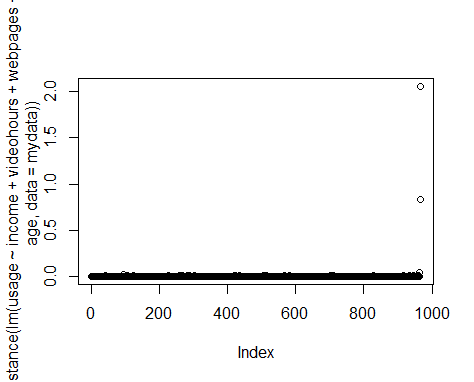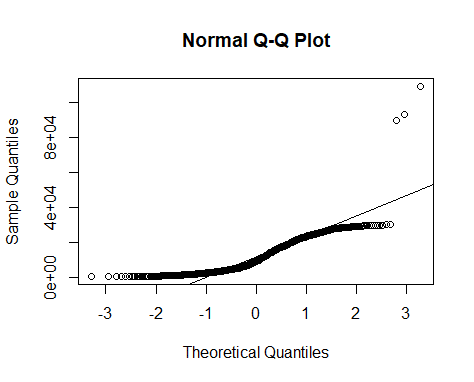It is often the case that a dataset contains significant outliers – or observations that are significantly out of range from the majority of other observations in our dataset. Let us see how we can use robust regressions to deal with this issue.
Plots
A useful way of dealing with outliers is by running a robust regression, or a regression that adjusts the weights assigned to each observation in order to reduce the skew resulting from the outliers.
In this particular example, we will build a regression to analyse internet usage in megabytes across different observations. You will see that we have several outliers in this dataset. Specifically, we have three incidences where internet consumption is vastly higher than other observations in the dataset.
Let’s see how we can use a robust regression to mitigate for these outliers.
Firstly, let’s plot Cook’s distance and the QQ Plot:
Cook’s Distance
QQ Plot
We can see that a plot of Cook’s distance shows clear outliers, and the QQ plot demonstrates the same (with a significant number of our observations not lying on the regression line).
When we get a summary of our data, we see that the maximum value for usage sharply exceeds the mean or median:
summary(mydata)
age gender webpages
Min. :19.00 Min. :0.0000 Min. : 10.00
1st Qu.:27.00 1st Qu.:0.0000 1st Qu.: 20.00
Median :37.00 Median :1.0000 Median : 25.00
Mean :37.94 Mean :0.5124 Mean : 29.64
3rd Qu.:48.75 3rd Qu.:1.0000 3rd Qu.: 32.00
Max. :60.00 Max. :1.0000 Max. :950.00
videohours income usage
Min. : 0.0000 Min. : 0 Min. : 500
1st Qu.: 0.4106 1st Qu.: 3503 1st Qu.: 3607
Median : 1.7417 Median : 6362 Median : 9155
Mean : 4.0229 Mean : 6179 Mean : 11955
3rd Qu.: 4.7765 3rd Qu.: 8652 3rd Qu.: 19361
Max. :45.0000 Max. :12000 Max. :108954
OLS Regression
Let’s now run a standard OLS regression and see what we come up with.
#OLS Regression
summary(ols <- lm(usage ~ income + videohours + webpages + gender + age, data = mydata))
Call:
lm(formula = usage ~ income + videohours + webpages + gender +
age, data = mydata)
Residuals:
Min 1Q Median 3Q Max
-10925 -2559 -479 2266 46030
Coefficients:
Estimate Std. Error t value Pr(>|t|)
(Intercept) -2.499e+03 4.893e+02 -5.107 3.96e-07 ***
income 7.874e-01 4.658e-02 16.903 < 2e-16 ***
videohours 1.172e+03 3.010e+01 38.939 < 2e-16 ***
webpages 5.414e+01 3.341e+00 16.208 < 2e-16 ***
gender -1.227e+02 2.650e+02 -0.463 0.643
age 8.781e+01 1.116e+01 7.871 9.50e-15 ***
---
Signif. codes: 0 ‘***’ 0.001 ‘**’ 0.01 ‘*’ 0.05 ‘.’ 0.1 ‘ ’ 1
Residual standard error: 4113 on 960 degrees of freedom
Multiple R-squared: 0.8371, Adjusted R-squared: 0.8363
F-statistic: 986.8 on 5 and 960 DF, p-value: < 2.2e-16
We see that along with the estimates, most of our observations are significant at the 5% level and the R-Squared is reasonably high at 0.8371.
However, we need to bear in mind that this regression is not accounting for the fact that significant outliers exist in our dataset.
Cook’s Distance
A method we can use to determine outliers in our dataset is Cook’s distance. As a rule of thumb, if Cook’s distance is greater than 1, or if the distance in absolute terms is significantly greater than others in the dataset, then this is a good indication that we are dealing with an outlier.
#Compute Cooks Distance
dist <- cooks.distance(ols)
dist<-data.frame(dist)
]s <- stdres(ols)
a <- cbind(mydata, dist, s)
#Sort in order of standardized residuals
sabs <- abs(s)
a <- cbind(mydata, dist, s, sabs)
asorted <- a[order(-sabs), ]
asorted[1:10, ]
age gender webpages videohours income usage dist
966 35 0 80 45.0000000 6700 108954 2.058817511
227 32 1 27 0.0000000 7830 24433 0.010733761
93 37 1 30 0.0000000 10744 27213 0.018822466
419 25 1 20 0.4952778 1767 17843 0.010178820
568 36 1 37 1.6666667 8360 25973 0.007652459
707 42 1 40 4.2347222 8527 29626 0.006085165
283 39 0 46 0.0000000 6244 22488 0.007099847
581 40 0 24 0.0000000 9746 23903 0.010620785
513 29 1 23 1.1111111 11398 25182 0.015107423
915 30 0 42 0.0000000 9455 22821 0.010412391
s sabs
966 11.687771 11.687771
227 4.048576 4.048576
93 4.026393 4.026393
419 3.707761 3.707761
568 3.627891 3.627891
707 3.583459 3.583459
283 3.448079 3.448079
581 3.393124 3.393124
513 3.353123 3.353123
915 3.162762 3.162762
We are adding Cook’s distance and standardized residuals to our dataset. Observe that we have the highest Cook’s distance and the highest standaridized residual for the observation with the greatest internet usage.
Huber and Bisquare Weights
At this point, we can now adjust the weights assigned to each observation to adjust our regression results accordingly.
Let’s see how we can do this using Huber and Bisquare weights.
Huber Weights
#Huber Weights
summary(rr.huber <- rlm(usage ~ income + videohours + webpages + gender + age, data = mydata))
Call: rlm(formula = usage ~ income + videohours + webpages + gender +
age, data = mydata)
Residuals:
Min 1Q Median 3Q Max
-11605.7 -2207.7 -177.2 2430.9 49960.3
Coefficients:
Value Std. Error t value
(Intercept) -3131.2512 423.0516 -7.4016
income 0.9059 0.0403 22.4945
videohours 1075.0703 26.0219 41.3140
webpages 57.1909 2.8880 19.8028
gender -173.4154 229.0994 -0.7569
age 88.6238 9.6455 9.1881
Residual standard error: 3449 on 960 degrees of freedom
huber <- data.frame(usage = mydata$usage, resid = rr.huber$resid, weight = rr.huber$w)
huber2 <- huber[order(rr.huber$w), ]
huber2[1:10, ]
usage resid weight
966 108954 49960.32 0.09284397
227 24433 16264.20 0.28518764
93 27213 15789.65 0.29375795
419 17843 15655.03 0.29628629
707 29626 14643.43 0.31675392
568 25973 14605.87 0.31756653
283 22488 13875.58 0.33427984
581 23903 13287.62 0.34907331
513 25182 13080.99 0.35458486
105 19606 12478.59 0.37170941
Bisquare weighting
#Bisquare weighting
rr.bisquare <- rlm(usage ~ income + videohours + webpages + gender + age, data=mydata, psi = psi.bisquare)
summary(rr.bisquare)
Call: rlm(formula = usage ~ income + videohours + webpages + gender +
age, data = mydata, psi = psi.bisquare)
Residuals:
Min 1Q Median 3Q Max
-11473.6 -2177.8 -119.7 2491.9 50000.1
Coefficients:
Value Std. Error t value
(Intercept) -3204.9051 426.9458 -7.5066
income 0.8985 0.0406 22.1074
videohours 1077.1598 26.2615 41.0167
webpages 56.3637 2.9146 19.3384
gender -156.7096 231.2082 -0.6778
age 90.2113 9.7343 9.2673
Residual standard error: 3434 on 960 degrees of freedom
bisqr <- data.frame(usage = mydata$usage, resid = rr.bisquare$resid, weight = rr.bisquare$w)
bisqr2 <- bisqr[order(rr.bisquare$w), ]
bisqr2[1:10, ]
usage resid weight
227 24433 16350.56 0.0000000000
966 108954 50000.09 0.0000000000
93 27213 15892.10 0.0005829225
419 17843 15700.87 0.0022639112
707 29626 14720.97 0.0264753021
568 25973 14694.59 0.0274546293
283 22488 13971.53 0.0604133298
581 23903 13389.67 0.0944155930
513 25182 13192.86 0.1072333000
105 19606 12536.39 0.1543038994
In both of the above instances, observe that a much lower weight of 0.092 is assigned to observation 966 using Huber weights, and a weight of 0 is assigned to the same observation using Bisquare weighting.
In this regard, we are allowing the respective regressions to adjust the weights in a way that yields lesser importance to outliers in our model.
Conclusion
In this tutorial, you have learned how to:
- Screen for outliers using Cook’s distance and QQ Plots
- Why standard linear regressions do not necessarily adjust for outliers
- How to use weighting techniques to adjust for such anomalies
If you have any questions on anything I have covered in this tutorial, please leave a comment and I will do my best to address your query.

